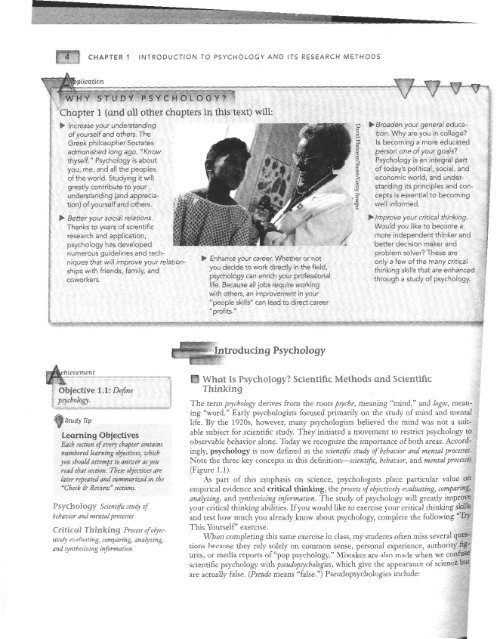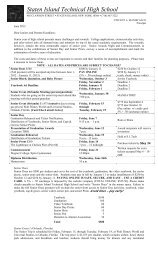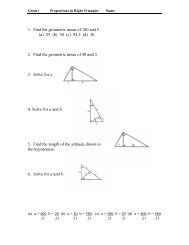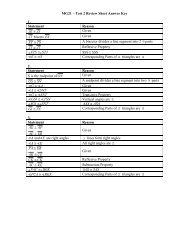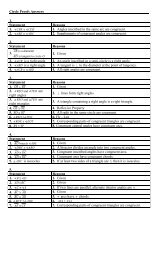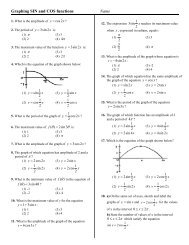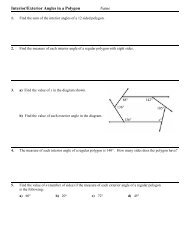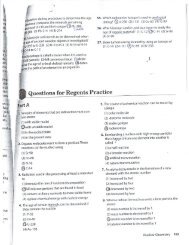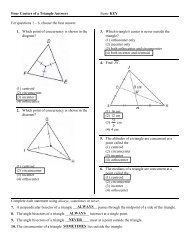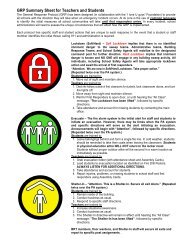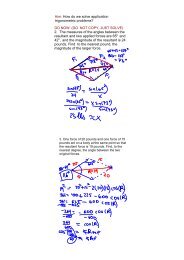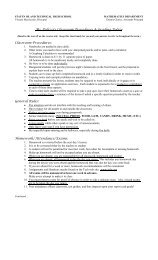Psychology Textbook Chapter 1 pages 4-15.pdf - Staten Island ...
Psychology Textbook Chapter 1 pages 4-15.pdf - Staten Island ...
Psychology Textbook Chapter 1 pages 4-15.pdf - Staten Island ...
- No tags were found...
You also want an ePaper? Increase the reach of your titles
YUMPU automatically turns print PDFs into web optimized ePapers that Google loves.
INTRODUCTION TO PSYCHOLOGY AND ITS RESEARCH METHODS<br />
<strong>Chapter</strong> 1 (and all other chapters in this text) will:<br />
K Increase your understanding<br />
of yourself and others. The<br />
Greek philosopher Socrates<br />
admonished long ago, "Know<br />
thyself." <strong>Psychology</strong> is about<br />
you, me, and all the peoples<br />
of the world. Studying it will<br />
greatly .contribute to your<br />
understanding (and apprecia-<br />
en your general educa-<br />
Is becoming a more educated<br />
person one of your goals<br />
<strong>Psychology</strong> is an integral part<br />
of today's political, social, and<br />
standing its principles and concepts<br />
is essential to becoming<br />
>• Better your social relations.<br />
Thanks to years of scientific<br />
Would you like to become a<br />
psychology has developed<br />
numer ------ '<br />
niques that will improve your rela<br />
ships with friends, farnily, and<br />
co workers.<br />
» Enhance your career. Whether or not<br />
you decide to work directly in the field,<br />
psychology can enrich your professional<br />
life. Because all jobs require working<br />
with others, an improvement in your<br />
"people skills" can lead to direct career<br />
"profits."<br />
better decision maker and<br />
problem solver These are<br />
thinking skills that are enhanced<br />
through a study of psychology.<br />
Introducing <strong>Psychology</strong><br />
Objective 1.1: Defin<br />
psychology.<br />
Learning Objectives<br />
Each section of every chapter contains<br />
numbered learning objectives, tuhkb<br />
<strong>Psychology</strong> Scientific study af<br />
behavior and mental processes<br />
Critical Thinking Process of objectively<br />
evaluating, comparing, analyzing,<br />
and synthesizing information<br />
^ What Is <strong>Psychology</strong> Scientific Methods and Scientific<br />
Thinking<br />
The term psychology derives from the roots psyche, meaning "mind," and logos, meaning<br />
"word." Early psychologists Focused primarily on the study of mind and mental<br />
life. By the 1920s, however, many psychologists believed the mind was not a suitable<br />
subject for scientific study. They initiated a movement to restrict psychology- to<br />
observable behavior alone. Today we recognize the importance of both areas. Accordingly,<br />
psychology is now defined as the scientist study of behavior and mental processes.<br />
Note the three key concepts in this definition—scientific, behavior, and mental processes<br />
(Figure 1.1).<br />
As part o£ this emphasis on science, psychologists place particular value oQ<br />
empirical evidence and critical thinking, the process o~j objeitnsb; ntJli'^nn^. c'lni'^inng:<br />
analyzing, and synthesizing information. The study of psychology will greatly improve<br />
your critical thinking abilities. If you would like to exercise your critical dunking skills<br />
and test how much you already know about psychology, complete the following "Try<br />
This Yourself exercise.<br />
When completing this same exercise in class, my students often miss several questions<br />
hecanse they rely solely on common sense, personal experience, authority fig'<br />
ures, or media reports of "pop psychology." Mistakes are also made when we confuse<br />
scientific psychology with pseudopsycbologies, which give the appearance of science but<br />
are actually false. (Pseudo means "false."} Pseiidopsychologies include:
INTRODUCING PSYCHOLOGY<br />
'jcqttcn<br />
Try This Yourself<br />
"• — ~ - -<br />
Testing Your Knowledge of <strong>Psychology</strong> 4. Punishrr<br />
: effective way 8. People with schizophrenia have<br />
Answer True or False to the following<br />
snge behavior.<br />
multiple personalities.<br />
to P er "<br />
5. Eyewitness testimony is often 9. Similarity is one of the best predic-<br />
__1, In general, we only use about 10 unreliable. tors of long-term relationships.<br />
percent of our brain. 6. Polygraph ("lie detector") tests 10. In an emergency, as the number of<br />
2. Most brain activity stops during can accurately and reliably reveal bystanders increases, your chance<br />
sleep. whether or not a person is lying. of getting help decreases.<br />
3. Advertisers arid politicians often use 7. People who threaten suicide seldom<br />
subliminal persuasion to influence follow through with it. ^<br />
als who are supposedly sensitive to nonphysical or supernatu-<br />
• Mediums—-individuals who serve as a channel of communication between the<br />
earthly world and a world of spirits.<br />
• Palmitfty—reading a person's future or character from the lines on die palms.<br />
• Psychomeiry—determining facts about an object by merely handling it.<br />
• Psychokinesis—moving objects by purely mental means.<br />
" Astrology—die study of how the positions of the stars and planets supposed!)<br />
influence people's personalities and affairs.<br />
For some, horoscopes or palmists are simple entertainment. Unfortunately, there<br />
are also true believers seeking guidance and comfort who waste large sums of money<br />
on charlatans purporting to know the future. Broken-hearted families have also lost<br />
valuable time and emotional energy on psychics claiming they could locate their lost<br />
children. As you can see, distinguishing scientific psychology from pseudopsychology<br />
is vitally important.<br />
Hf Study Tip<br />
Try This Yourself<br />
educational. Active learning greatly<br />
Scientific is a key part of die<br />
definition of psychology.<br />
Psychological science collect<br />
and evaluates information<br />
using systematic observations<br />
^ Study Tip<br />
Website Icons<br />
Note the -a/eb site icon and address at<br />
the bottom of every right-hand page.<br />
It includes free online wtffrial quizzes,<br />
practice tests, active learning exercises,<br />
Internet links to psychology-related<br />
topics, and other valuable features that<br />
site often. It -will help ensure success in<br />
: igure1.1 Defining psychology
CHAPTER 1 INTRODUCTION TO PSYCHOLOGY AND ITS RESEARCH METHODS<br />
"The Amazing Randt" The magician<br />
Jams; Randt i.n dedicitied bis /;/,"' to<br />
educating the public about fraudulent<br />
pseudopsycbologists. Alang with the prestigious<br />
MacArtbur Foundation* Rondi has<br />
offered $1 million to "anyone who proms<br />
a genuine psychic power under proper observing<br />
conditions" (About James Randi,<br />
2002; Randi, 1997). After many years,<br />
the money has never been collected. If you<br />
would tike more information, visit Sandi's<br />
Objective 1.2: What a<br />
ecology's fourmain goalsf<br />
Nature-Nurture Controversy<br />
Ongoing dispute over the relative contributions<br />
of nature (heredity) and nurture<br />
W Study Tip<br />
Key Terms and Running<br />
Glossary<br />
All key terms and concepts are boldfaced<br />
in the text, and then defined<br />
and running glossary provide a helpterms.<br />
Key terms from all chapters<br />
the end of this text.<br />
GI <strong>Psychology</strong>'s Goals: Describe, Explain, Predict, and Change<br />
In contrast to pseudopsychologies, which rely on testimonials and opinions, psychology<br />
bases its findings on rigorous, scientific methods. When conducting their<br />
research, psychologists have four basic goals: ro .;W< •;'/'
stop addictive behaviors, become less depressed, improve their family relationships,<br />
• and so on. Furthermore, as you know from personal experience, it is very difficult (if<br />
not impossible) to change someone against her or his will. (Joke question: Do you know<br />
how many psychologists it takes to change a light hulb Ansistr: None. The light bulb<br />
has to want to change itself!)<br />
INTRODUCING PSYCHOLOGY |f<br />
$Sstu({yTip<br />
Check & Review<br />
Each vta/or topic concludes with an<br />
questions that atkwyau to stop ana check<br />
concepts just discussed. Ambers appear<br />
in Appendix B at the back of the text.<br />
fJLaeutnent tfjjL. ^^ ^^ ^ -*•<br />
|lk~~i= —"^5pp~<br />
*|C HECK & REVIEW ^^<br />
Introducing <strong>Psychology</strong><br />
a- psychology<br />
b. critical thinking<br />
Objective 1.1: Define psychology.<br />
c behaviorism<br />
<strong>Psychology</strong> is the scientific study of behav- d. the scientific method<br />
brand mental processes. It emphasizes the 2. rely on nonsdentific or deliberately<br />
empirical approach and the value of criti- fraudulent methods to explain personality.<br />
cal thinking. Psychoiogy is not the same a. Pseudopsychologies<br />
as common sense, "pop psychology," or b. Sociologists<br />
pseudo psycho logy<br />
c. Astronomers<br />
d Counselors<br />
Objective 1.2: What are psychology's 3 P5ychological science often questions<br />
four main goals<br />
to what extent we are controlled by<br />
The goals of psychology are to describe, biological and genetic factors or by the<br />
explain, predict, and change behavior and environment and learning. This ongoing<br />
mental processes. debate is known as the .<br />
a child. This illustrates psychology's<br />
goal of behavior,<br />
a. describing<br />
b. explaining<br />
d. changing<br />
5. The goal of is to tell "what" occurred,<br />
whereas the goal of is to<br />
tell "why."<br />
a. health psychologists; biological<br />
psychologists<br />
c. psychologists; psychiatrists<br />
d. pseudopsychologists; clinical<br />
psychologists<br />
Questions<br />
• 1. The process of objectively evaluating,<br />
|>; ^S^t^''<br />
d. biopsychosocial mode!<br />
Check your answers in Appendix B.<br />
flHB Click & Review<br />
••«• foraclcllt|ona|assessrnsnto P t|0ns:<br />
UB^^I wiley.com/coliege/huffman<br />
fea ^PSYCHOLOGY AT WORK<br />
Bl ' '<br />
Careers in the Field<br />
Knowing what psychology is, and understanding its four major goals, would you<br />
consider a career in the field Many students think of psychologists only as therapists.<br />
However, many psychologists work as researchers, teachers, and consultants hi academic,<br />
business, industry, and government settings (Table 1.1). Many psychologists<br />
also work in a combination of settings. Your college psychology instructor may be an<br />
experimental psychologist who teaches, conducts research, and works as a paid business<br />
or government consultant— all at the same time. Similarly, a clinical psychologist<br />
might be a full-time therapist, while also teaching college courses.<br />
What is the difference between a psychiatrist and a clinical or counseling<br />
Psychologist The joke answer would be "about $100 an hour." The serious answer<br />
is that psychiatrists are medical doctors. They have M.D. degrees with a specialization<br />
in psychiatry acid a license ro prescribe medications and drugs. In contrast, most<br />
counseling and clinical psychologists have advanced degrees in human behavior and<br />
methods of therapy (e.g., Ph.D. or Psy.D.). Many clinical and counseling 1 psychologists<br />
. 3 lso work as a team with psychiatrists.<br />
j^-,<br />
«K<br />
Objective 1.3: Suinmarisze psy-<br />
: chology's major career specialties.<br />
OH Study Tip<br />
<strong>Psychology</strong> At Work<br />
many -ways to use and apply your<br />
Some sections are related to work,<br />
•whereas others involve relationships<br />
and everyday life,<br />
& Study Tip<br />
Narrative Questions<br />
These boldfaced narrative question*<br />
are part of the SQ4R method<br />
described in the Preftue. They help<br />
comprehension.
CHAPTER 1 INTRODUCTION TO PSYCHOLOGY AND ITS RESEARCH METHODS<br />
1.1 SAMPLE CAREERS AND SPECIALTIES IN PSYCHOLOGY<br />
Biopsychology/<br />
neuroscience<br />
Investigates the relationship between biology,<br />
behavior, and mental processes, including<br />
how physical and chemical processes affect the<br />
structure and function of the brain and nervous<br />
systetn.<br />
Oinical psychology Specialize nthc valuation, diagnosis, and<br />
il and behavioral disorders.<br />
Riopsycbology/neurosrience. Candace Pert (and<br />
others) identifa J!/'; body's miiurslpainkillers called<br />
Cognitive psychology Examines '"higher" n: ntal processes, including<br />
thought, memory, inl Diligence, creativity, and<br />
language.<br />
Counseling psychology<br />
Overlaps with clinical psychology, but practitioi<br />
ers tend to work with less seriously disturbed<br />
individuals and conduct more career and voca-<br />
Development<br />
psychology<br />
Educational and school<br />
psychology<br />
Studies rhc course of human growth and<br />
development from conception until death.<br />
Studies the process of education and works ti<br />
promote the intellectual, social, and emotion<br />
development of children in die school<br />
Clinical and counseling psychology. For<br />
people, this is the role they commonly assaciai<br />
psychology.<br />
Experimental<br />
psychology<br />
c psychology<br />
ch a- learn:na. conditionexperimental<br />
psychologist is somewhat misleading<br />
because pii'.'hukiifbr; v, orkiiig in almost all<br />
areas of specialization also conduct research.)<br />
Applies principles of psychology to the legal<br />
system, including jury selection, psychological<br />
profiling, and so on.<br />
G«nder and/or<br />
psychology<br />
Investigates rum- r<br />
cultures differ froi<br />
are similar.<br />
en and differen<br />
r and how they<br />
Experimental psychology. Louis Herman's re.<br />
•with dolphins has provided important insight int<br />
•man andnoah'hi.ir. fab^im tmJmental proces<br />
Health psychology'<br />
Industrial/organizational<br />
psychology<br />
Studies how bioln^cal. psychological, and s<br />
factors affect health and illness.<br />
Applies the principles of psychology to die<br />
workplace, including personnel selection and<br />
evaluation, leadership, job satisfaction, employee<br />
motivation, and group processes within die<br />
Social psychology<br />
Investigates die role of social forces and interpersonal<br />
behavior, including aggression, prejudice,<br />
love, helping, conformity, and attitudes.<br />
Psychologists often wear many hats. DJII<br />
teaches full-time at trident technical College, serves<br />
as Department Chair, and aim -works with faculty an
ORIGINS OF PSYCHOLOGY<br />
^Study Tip<br />
Illustrations<br />
Do not skip oner the photos, figures,<br />
and fables. They visually reinforce<br />
important cmtefts and often contain<br />
'material that may appear on exams.<br />
Counseling 113% -<br />
Figure 1.2 Percentage of psychology degrees awardtd by subfield Note that this is a small<br />
=,iiiipli;u of the mime.-0,1= =>•[ i.,h\ area-, in :i=yi-ln.i.'jy\. [he pciciTH.iyes ihov.-j; here are<br />
based on data from the American Psychological Awjcisririn lAPA), the largest professional<br />
psychological organization. The other major organization is die American Psychological<br />
Society (APS). Source: American Psychological Association, 2004.<br />
To get an idea of the relative number of psychologists working m different fields of<br />
psychology, see Figure 1.2. If you are considering a career in psychology, this test will<br />
also present a rich variety of career options that may interest you. For example, <strong>Chapter</strong><br />
2 looks at the world of neuroscience. After studying it, you may decide you would like a<br />
career as a neuroscien( lo/b'opsi diologist. <strong>Chapter</strong> 3 explores health psychology and the<br />
work of health psychologists. And <strong>Chapter</strong>s 4 and 15 examine problems in mental health<br />
and how therapists treat diem. If you find a particular area of interest, ask your instructor<br />
and campus career counselors for further career guidance. It's also a good idea to check<br />
out (he American Psychological Association's (APA) home page (http://www.af<br />
the American Psychological Society's (APS) website (http://w<br />
org). <strong>Psychology</strong> is always looking "for a few good men"—and women.<br />
Origins of <strong>Psychology</strong><br />
People have always been interested in human nature. Most of the great historical scholars,<br />
from Socrates and Aristotle to Bacon and Descartes, asked questions that we wouid<br />
today call psychological. What motivates people How do we think and problem solve<br />
Where do our emotions and reason reside Do our emotions control us, or are they<br />
something we can control Interest in such topics remained fyu-j^-lv Emon^ philosopher-.<br />
theologians, and writers for several thousand years. However, in the lace nineteenth<br />
century, psychological science began to emerge as a separate scientific discipline.<br />
Throughout its short history, psychologies have adopted several perspectives<br />
on the "appropriate" topics for psychological research and the "proper" research<br />
methods. As a student, you may find these multiple (and sometimes contradictory)<br />
approaches frustrating and confusing. However, diversity and debate have always been<br />
the lifeblood of science and scientific progress.<br />
ill Early Psychological Science: A Brief History<br />
Wihelm Wundc (Vill-helm Voont), generally acknowledged as the "father of psychology,"<br />
established the first psychological laboratory in Leipzig, Germany in 1879. He<br />
also helped train the first scientific psychologists, and wrote one of psychology's most<br />
important books, Prircit>i'c< ot ['/."^/nh^ii.n <strong>Psychology</strong>.<br />
Wundt and his followers were interested primarily in studying mental life and conscious<br />
experience—how we form sensations, images, and feelings. One of their earliest<br />
research methods was termed introspection, monitoring and reporting on the contents<br />
of consciousness (Goodwin, 2009). If you were one of Wundt's participants trained in
INTRODUCTION TO PSYCHOLOGY AND ITS RESEARCH METHODS<br />
Flry This Yourself<br />
How would you describe this object<br />
It yo: a participant in Titchener's laboratory, you woulc<br />
ot what it is, but your subjective experience—the<br />
intensity and clarity of color, texture, shape, and smell. Structuralists<br />
called this research method introspection. The fad<br />
that your reported experience might differ from others, or tha<br />
Titchener had no way to check the accuracy of your report,<br />
created significant problems for the structuralists.<br />
would be told to focus solely on the dicb and report only your immediate reactions to<br />
them—your basic sensations and feelings.<br />
Structuralism<br />
Edward Titchener brought Wundt's ideas to the United States and established a psychological<br />
laboratory at Cornell University. Titchener was a kind of mental chemist<br />
who sought to identify the basic building blocks, or structures, of the mind. Titchener's<br />
approach later came to be known as structuralism, which dealt with the structure of<br />
mental life. Just as the elements hydrogen and oxygen combine to form the compound<br />
water, Wundt believed the "elements" of conscious experience combined to form the<br />
"compounds" of the mind. Structuralists sought to identify the elements of thought<br />
the whole of experience.<br />
Unfortunately, it soon became clear that structuralism was doomed to failure.<br />
When different observers introspected and then disagreed on their experiences, no<br />
scientific way existed to settle the dispute. Furthermore, introspection could not be<br />
used to study nonhuman animals, children, or complex topics like mental disorders<br />
or personality. Though short-lived, structuralism established a model for studying<br />
mental processes scientifically,<br />
William James (1842-1910).<br />
James was a leading farce in the functionalist<br />
school of psychology, which stressed<br />
the adaptive and practical functions of<br />
human l-fh.-n v,i:<br />
Psychoanalytic/Psychodynamic<br />
Perspective Focuses m vactmsdous<br />
Functionalism<br />
Structuralism's intellectual successur, ftiTictivnalism, studied how the mind functions to adapt<br />
human and nonhuman animals to their environment. Earlier structuralists might have<br />
studied "anger" hv .mkinsi people to introspect and report on their individual experiences.<br />
In comparison, functionalists would have asked, "Why do we have the emotion of anger<br />
What function does it server Haw does it help us adapt to our environment" As you can<br />
see, funetionalism was strongly influenced by Darwin's theory of evolution and his emphasis<br />
on natural selection (Segerstrale, 2000).<br />
William James, an American scholar, was a leading force in the functionalist<br />
school. He also broadened psychology to include nonhuman animal behavior, various<br />
biological processes, and behaviors. In addition, his book Principles of <strong>Psychology</strong> (1890)<br />
became die leading psychology text—despite its length of more than 1400 <strong>pages</strong>!<br />
Like structuralism, funetionalism eventually declined. But it expanded the scope of<br />
psychology to include research on emotions and observable behaviors, initiated the psychological<br />
testing movement, and changed the course of modem education and industry.<br />
FsychoanuIytiLVTsyUioUyHuinK, Perspective<br />
During the late 1800s and early 1900s, while fuBCtionalism was prominent in the<br />
United States, the psychoanalytic/psychodyiiamic perspective was fanning in<br />
Europe. Its founder, Austrian physician Sigmund Freud, believed that many psychological<br />
nrohlems are caused liv conflict's between "acceptable" behavior and "unacceptable"
unconscious sexual or aggressive motives (<strong>Chapter</strong> 13). To deai with<br />
these unconscious conflicts, Freud developed a form of psychotherapy,<br />
or "talk therapy," Called psychoanalysis.<br />
Freud's nonscientine approach and emphasis on sexual and aggressive<br />
impulses have long been controversial, and today there are few<br />
strictly Freudian psychoanalysts left. But the broad features of his<br />
theory remain in the modern psychodynamic approach. Although psychodynamic<br />
psychologists are making increasing use of experimental<br />
methods, their primary method is the analysis of case studies. Their<br />
primary goal is to interpret complex meanings hypothesized to underlie<br />
people's actions.<br />
Behavioral Perspective<br />
In the early 1900s, another major school of thought appeared that dramatically<br />
shaped the course of psychology. Unlike earlier approaches,<br />
the behavioral perspective emphasises objective, observable environmental<br />
influences on overt behavior.<br />
John B. Watson (1913), the acknowledged founder of behaviorism, rejected<br />
the practice of introspection and the influence of unconscious forces. He believed<br />
these practices and topics were unscientific and too obscure to be studied<br />
empirically. Watson adopted Russian physiologist Ivan Pavlov's concept<br />
of conditioning to explain how behavior results from observable stimuli<br />
(in the environment) and observable responses (behavioral actions). In<br />
Pavlov's famous experiment teaching a dog to salivate in response to<br />
the sound of a bell, the beli is die stimulus and the salivation is the<br />
response.<br />
Because nonhuman animals are ideal subjects for studying objective,<br />
overt behaviors, the majority of early behavior research was done with<br />
them or with techniques developed through nonhuman research. Using<br />
dogs, rats, pigeons, and other nonhuman animals, behaviorists such as John<br />
Watson in the early 1900s and, more recently B. F. Skinner, focused primarily<br />
on learning and how behaviors are acquired. They formulated a number<br />
of basic principles about learning which are explored in <strong>Chapter</strong> 6.<br />
Behavioral Perspective Empba-<br />
It sounds like behaviorists are interested only in nonhuman animals.<br />
Aren't any of them interested in humans Yes, behaviorists are interested<br />
in people. One of the most well-known behaviorists, B. E Skinner, was convinced diat<br />
we could (and should) use behavior approaches to actually "shape" human behavior.<br />
This shaping could thereby change the present negative course (as he perceived it) of<br />
humankind. He did considerable writing and lecturing to convince others of this position.<br />
Behaviorists have been most successful in treating people with overt (observable,<br />
behavioral) problems, such as phobias (irrational fears) and alcoholism (<strong>Chapter</strong>s 14<br />
and 15) (Watson & Tharp, 2007).<br />
Hurnanistic Perspective<br />
In sharp contrast to psychoanalysts and behaviorists who saw human behavior as<br />
shaped and determined by external causes beyond personal control, humanists emphasized<br />
our unique ability to make voluntary choices about our own behavior and life.<br />
The humanistic perspective stresses free will, self-actualization, and human nature<br />
as naturally positive and growth seeking. According to Carl Rogers and Abraham<br />
Maslow, two central figures in the development of humanism, all individuals naturally<br />
strive to grow, develop, and move toward self-actualization (a state of self-fulfillment<br />
in which we realize our highest potential).<br />
Many psychologists have criticized the humanistic approach for its lack of rigorous<br />
experimental mediods and consider it more of a philosophy of life than a major<br />
Humanistic Perspective<br />
Emphasizes free will, self-actualization,<br />
and human nature as naturally positive
CHAPTER 1 INTRODUCTION TO PSYCHOLOGY AND ITS RESEARCH METHODS<br />
Positive <strong>Psychology</strong> Scientific<br />
study oj<br />
Cognitive Perspective Foe,<br />
on thinking, perceiving, and inform<br />
processing<br />
® Study Tip<br />
Throughout this text, you "j,<br />
dates) at the end of many sentenct<br />
such as (Goodwin, 2009). Most a<br />
the names and dates in parentheses.<br />
for research projects, for additional<br />
information on a topic of interest, and<br />
to double-check the research sources.<br />
Complete publication information (title<br />
name or book title, date, and page<br />
section at the back of this book.<br />
Neuroscience/Bi opsychology<br />
Perspective Emphasizes genetics and<br />
other biological processes in the brain and<br />
other parts of the nervous system<br />
Evolutionary Perspective<br />
and evolution af behavior and mental<br />
perspective in scientific psychology. Hov<br />
behaviorism, has had an important influi<br />
therapy (see <strong>Chapter</strong>s 13 and 15).<br />
er, humanism, like psychoanalysis ant<br />
e on personality theories and psycho<br />
In addition, the humanistic approach provides the foundation for a contemporary<br />
research specialty known as positive psychology—the scientific study of optimal<br />
human functioning (Diener, 2008; Patterson & Joseph, 2007; Seligman, 2003,<br />
2007; Taylor & Sherman, 2008). For many years, psychology understandably<br />
focused on negative states, such as aggression, depression, and prejudice.<br />
In recent years, however, leaders in the positive psychology movement,<br />
such as Ed Diener, Martin Seligman, and Shelly Taylor, have pushed for a<br />
broader study of human experiences, with an emphasis on: (1) positive emotions<br />
(like hope, love, and happiness), (2) positive traits (such as altruism, courage,<br />
and compassion), and (3) positive institutions that help promote better lives<br />
(such as improved schools and healthier families) (Seligman, 2003). Thanks<br />
to its scientific methodology and broader focus on optimal functioning,<br />
positive psychology has provided a wealth of new research found throughout<br />
this text.<br />
Cognitive Perspective<br />
One of the most influential modern approaches, the cognitive perspective, recalls<br />
psychology's earliest days, in that it emphasizes dunking, perceiving, and information<br />
processing. (Sternberg, 2009).<br />
Modern-day cognitive psychologists, however, ^niily hov. «t- t-M^er, encode.<br />
These processes Include thinking, perception, memory, language, and problem solving.<br />
If you were listening to a friend describe her whitewater rafting trip, a cognitive<br />
psychologist would be interested in how you decipher the meaning other words, how<br />
you form mental images of the turbulent water, how you incorporate your impressions<br />
of her experience into your previous concepts and experience of rafting, and so on.<br />
Many cognitive psychologists use an information-processing approach, likening<br />
the mind to a computer that sequentially takes in information, processes it, and then<br />
produces a response.<br />
Neuroscience/Biopsychology Perspective<br />
During the bit few liecjdei-, ,dcnri:,i> have explored the role of biological factors in almost<br />
every area of psychology, including sensation, perception, learning, memory, language,<br />
sexuality, and obtionn,]! beli.n ior. I hi^ exploration has given rise to an increasingly important<br />
trend in psychology, known as the neuroscience/biopsychology perspective.<br />
As you will see in the upcoming discussion of psychological research in this<br />
chapter, neuroscientists/biopsychologists have developed sophisticated "tools" and<br />
technologies to conduct their research. They use these tools to study the structure<br />
and function of individual nerve ceils, the roles of various parts of the brain, and<br />
how genetics and other biological processes contribute to our behavior and mental<br />
processes. We will return to the neuroscience/biopsychology perspective throughout<br />
<strong>Chapter</strong> 2 and other chapters.<br />
Evolutionary Perspective<br />
The evolutionary perspective derives from a focus on natural selection, adaptation,<br />
and evolution of behavior and mental processes (Buss, 2008; Workman & Reader, 2008).<br />
Its proponents argue that natural selecdon favors behaviors that enhance an organism's<br />
icpiuducuvc success. Thai is, human and iioidiuataii animals uAliibiuiig Udiaviuis dial<br />
contribute to survival will pass them on through their genes to the next generation.<br />
Consider aggression. Behaviorists would argue that we learn aggressiveness at an<br />
early age. "Hitting anotiier child stops him or her from taking your toys." Cognitive<br />
psychologists would emphasize how thoughts contribure to aggression. "He intended<br />
to hurt me. Therefore, I should hit him back!" Neuroscience/biopsychologists might
ORIGINS OF PSYCHOLOGY<br />
structures in the brain. In comparison, evolutionary psychoiogists would &<br />
argue that human and nonhuman animals behave aggressively because |<br />
aggression conveys a survival or reproductive advantage. They believe ^<br />
aggression evolved over many generations because it successfully met the g<br />
adaptive pressures faced by our ancestors.<br />
Socioculturol Perspective<br />
The sociocultural perspective emphasizes social interactions and cultural<br />
determinants of behavior and mental processes. Sociocultural psychologists<br />
have shown how factors such as ethnicity, religion, occupation, and socioeconomic<br />
class all have an enormous psychological impact (Laungani, 2007;<br />
Shiraev & Levy, 2008).<br />
Unless someone points it out, however, few of us recognize the importance<br />
of these factors. As Segall and his colleagues (1990) suggest, when you n ,<br />
go to school, you probably walk into a classroom at the same time on the<br />
same days, sit in the same chair, and either listen to a trained teacher or participate<br />
in an activity designed and directed by that teacher. This is because Guin<br />
it is the schooling system of your social world and culture. In another society<br />
or culture, such as a remote reman of EJ^C Africa, you and your friends might gather<br />
informally around a respected elder, some of you sitting and others standing, all of you<br />
listening to the elder tell stories of the history of the tribe.<br />
As they say, "a fish doesn't know it is in water," and, similarly, most of us are unaware<br />
of the social and cultural forces that shape our lives. This is one of many reasons<br />
why we include such heavy coverage of sociocultural psychology throughout this text.<br />
<strong>Psychology</strong> in a global<br />
'.only Technological<br />
ication for people who<br />
-ted from events m the rest of<br />
• think these changes affect these<br />
bland in West Papua New<br />
Sociocultural Perspective<br />
Emphasizes social interaction and cultural<br />
determin<br />
Women and Minorities<br />
During the late 1800s and early 1900s, most colleges and universities provided litde<br />
opportunity for women and minorities, as either students or faculty. Despite these<br />
early limitations, both women and minorities have made important contributions to<br />
psychology.<br />
One of the first women to be recognized in the field was Mary Calkins. Calkins<br />
performed valuable research on memory and in 1905 served as die first female<br />
president of the American Psychological Association (APA). Her achievements are<br />
particularly noteworthy, considering the ^itrnilicanL discrimination against women in<br />
those times. Even after completing all the requirements for a Ph.D. at Harvard, and<br />
being described by William James as his brig-htest student, the university refused to<br />
grant the degree to a woman. The first woman to receive a Ph.D. in psychology was<br />
Margaret Floy Washburn (in 1894), who wrote several influential boolcs and served as<br />
die second female president of APA.<br />
Francis Cecil Sumner, without benefit of a formal high school education,<br />
became the first African American to earn a Ph.D. in psychology<br />
from Clark University in 1920. He also translated over 3000 arti-<br />
African<br />
cles from German, French, and Spanish and founded one of the American<br />
country's leading psychology departments at Howard University. In<br />
1971, one of Sumner's students, Kenneth B. Clark, became the first<br />
African American to be elected APA president. Clark's research with<br />
his wife, Mamie Clark, documented the harmful effects of prejudice<br />
and directly influenced the Supreme Court's ultimate ruling against<br />
racial segregation in schools.<br />
Sumner and Clark, Olkin^ -inn \\ a-Jibum. jiong with other important<br />
minorities and women, made significant and lasting 1 contributions (<br />
:o the developing science of psychology. In recent years, minorities and<br />
A'omen are being actively encouraged to pursue graduate degrees in psy-<br />
:hology. But as you can see in Figure 1.3, white (non-Hispanic) people<br />
(till make up the majority of new docrorare recipients in psychology. F<br />
Kenneth Clark (1914-2005) Kenmtb<br />
Clark was the first African American<br />
president of the American Psychological<br />
Association. He and his -wife, Mamie, also<br />
cited in 1964 by the U.S. Supreme Court.
CHAPTER 1 INTRODUCTION TO PSYCHOLOGY AND ITS RESEARCH METHODS<br />
€1 Modern Perspectives: Seven Approaches and<br />
One Unifying Theme<br />
Early schools like structuralism and fiinctionalism have almost entirely disappeared<br />
or have been blended into newer, broader perspectives. Contemporary psychology<br />
reflects seven major perspectives: psychuanalytic/psychodynarnii. beb,rj:tiral, humanistic,<br />
cognitive, neuroscience/biopsycbology, evolutionary, and sociocultural (Table 1.2).<br />
In discussing the seven modern perspectives in psychology, I have presented diem<br />
separately and made distinctions between their philosophies and practices. However,<br />
most psychologists rcco^ni/L- tht.- \ :duc ot c;iLh oneni.iuoii. .uiJ a»ree that no one view<br />
has ali the answers.<br />
One of the most widely accepted, and unifying, themes of modern psychology is<br />
the biopsychosocial model. This approach views biologicii! prucc'-'iiJ 1 - is.sj,, genetics,<br />
brain functions, neurotransmitters, and evolution), psychological factors (e.g., learning,<br />
thinking, emotion, personality, and motivation), and social forces (e.g., family, culture,<br />
ethnicity, social class, and politics) as interrelated influences (Figure 1.4).<br />
TABLE1.2 PSYCHOLOGY'S SEVEN MODERN PERSPECTIVES<br />
Perspectives<br />
Major Emphases<br />
Biopsychosocial Model Unifying<br />
theme of modern psychology that incorpoil<br />
Psychoanalytic/psychodynamic<br />
ssolved past conflicts<br />
Free will, self-actualization, and human nature as naturally positive<br />
and growth-seeking<br />
Cognitive<br />
Thinking, perceiving, problem solving, memory, language, and<br />
information processing<br />
Neuroscience/biopsychology<br />
Genetics and biological processes in the brain and other parts of<br />
the nervous system<br />
Evolutionary
ORIGINS OF PSYCHOLOGY<br />
Try This Yourself<br />
Why do we need multiple and<br />
competing perspectives<br />
What do you see in the drawing to the right Do you see<br />
two profiles facing each other or a white vase Your ability to<br />
see both figures is similar to a psychologist's ability to study<br />
behavior and mental processes from a number of different<br />
perspectives.<br />
This new, mtegrative model proposes that<br />
all three forces affect and are affected by one<br />
another. They are inseparable. For example,<br />
feelings of depression are often infhienced by<br />
genetics and neu retransmitters (biology). They<br />
are also affected by our learned responses and<br />
patterns of thinking q>.-\ cholotry.! and by our<br />
socioeconomic status and cultural views of<br />
emotion (social). In the coming chapters, I freq<br />
uently refer to one or more of the seven major<br />
perspectives shown in Table 1.2. However,<br />
the common theme of modern psychology,<br />
and this text, is an integrative, biopsycbosocial<br />
approach.<br />
; ! A The biopsycbosocial model<br />
combines and interacts with the seven<br />
major perspectives<br />
i E W<br />
Origins of <strong>Psychology</strong><br />
Objective 1.3: Summarize psychology's<br />
major career specialties.<br />
Many avenues exist for those who want to<br />
pursue a career in psychology. These include<br />
biopsychology/neuroscience, experimental,<br />
cognitive, developmental, clinical, counseling,<br />
industrial/organizational, educational/<br />
school, social, health, and so on.<br />
Objective 1.4: Contrast structuralism<br />
versus functionalism, and list the seven<br />
major perspectives that guide modern<br />
psychology.<br />
Among the early contributors to psychology,<br />
the structuralists sought to identify<br />
elements of consciousness and how those<br />
elements formed the structure of the mind<br />
They relied primarily on the method of<br />
introspection. Functionalists studied how<br />
The psychoanafytic/psychodynamic,<br />
roscience/biopsychology, evolutionary,<br />
and sociocultural perspectives are the<br />
key approaches in contemporary psychology.<br />
Objective 1.5: Describe the biopsychosocial<br />
model.<br />
The b i op sycho social model draws from<br />
all seven modern perspectives and also<br />
incorporates biological, psychological,<br />
nated the method of introspection to<br />
examine thoughts and feelings.<br />
4. Which of the following terms do noi<br />
observable behavior; (b) behaviorisr<br />
5. Define the biopsychosociai model.<br />
;r in Appendix B<br />
I Click & Review<br />
I lor additional assessment opiion'<br />
ley.com/coilege/huffm


